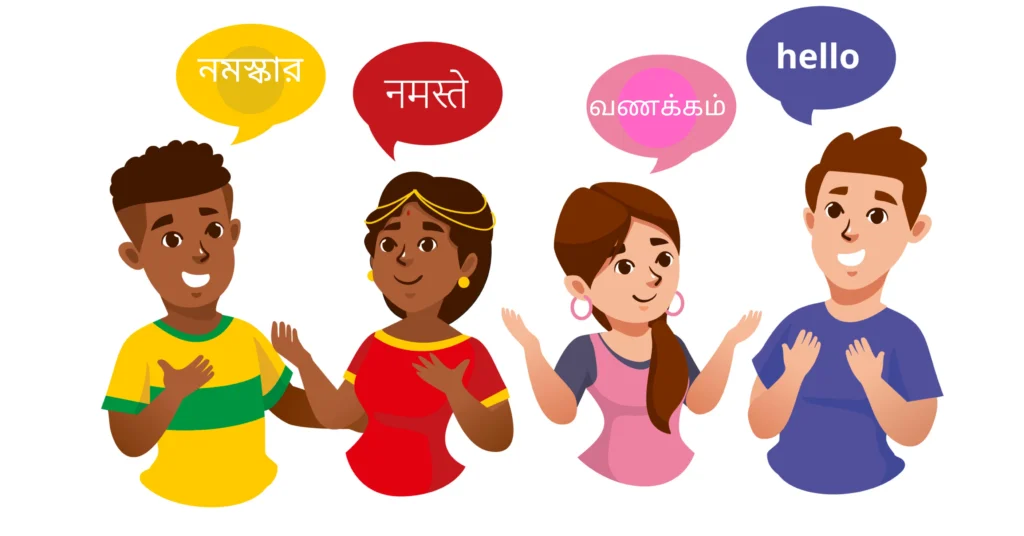What is a language?
Languages is a system of communication that uses symbols, such as spoken or written words, gestures, or signs, to convey meaning. It’s a way for people to express thoughts, ideas, emotions, and information.
What is language of india?
India is one of the most linguistically diverse countries in the world, boasting 22 officially recognized languages under the Eighth Schedule of the Indian Constitution. Hindi, spoken by a significant portion of the population, serves as the primary official language, while English acts as an associate language for communication and administration. Other prominent languages include Bengali, Telugu, Marathi, Tamil, Urdu, and Gujarati, each reflecting the unique culture and heritage of their respective regions. Additionally, thousands of dialects and languages exist, showcasing the rich tapestry of linguistic diversity in India. This multilingual landscape plays a crucial role in shaping India’s identity.

Official languages of India
Official languages of India
Here’s a grid of the official languages of India as per the Eighth Schedule of the Constitution:
| Number | Language |
|---|---|
| 1 | Assamese |
| 2 | Bengali |
| 3 | Bodo |
| 4 | Dogri |
| 5 | Gujarati |
| 6 | Hindi |
| 7 | Kannada |
| 8 | Kashmiri |
| 9 | Konkani |
| 10 | Maithili |
| 11 | Malayalam |
| 12 | Manipuri |
| 13 | Marathi |
| 14 | Nepali |
| 15 | Odia |
| 16 | Punjabi |
| 17 | Sanskrit |
| 18 | Santali |
| 19 | Sindhi |
| 20 | Tamil |
| 21 | Telugu |
| 22 | Urdu |
This grid summarizes the officially recognized languages in India
Uses of languages:
India is a linguistically diverse country with a rich tapestry of languages spoken across its regions. The uses of language in India are multifaceted and deeply embedded in its cultural, social, and political fabric. Here are some key aspects:
- **Communication**: Language is the primary means of communication between individuals and groups. In India, with its myriad languages and dialects, communication often happens in regional languages or Hindi, which serves as a link language in many areas.
- **Education**: Language plays a crucial role in education. India’s educational system often uses regional languages for primary education, while Hindi or English might be used for secondary and higher education. Multilingualism is common, with students learning in their mother tongue while also being educated in English or other major languages.
- **Government and Administration**: India has a multilingual administrative framework. Hindi and English are the official languages of the central government, but states and Union Territories use their own languages for official purposes. This includes legislative proceedings, judicial matters, and public administration
- **Media and Entertainment**: Language is vital in the media and entertainment industry. India has a robust film industry in several languages, including Bollywood (Hindi), Tollywood (Telugu), Kollywood (Tamil), and others. Regional language newspapers, television channels, and radio stations cater to diverse linguistic communities.
- **Cultural Expression**: Language is a key medium for cultural expression. Literature, poetry, music, and folk traditions are often deeply tied to specific languages. Festivals, rituals, and traditional practices are also expressed and preserved through language.
- **Identity and Social Cohesion**: Language is a significant marker of identity. It can signify regional, cultural, and ethnic affiliations. In some cases, language movements and regional linguistic pride play a role in political and social dynamics.
- **Business and Commerce**: In the business world, English is commonly used for national and international trade and commerce. However, regional languages are often used in local markets and interactions. Multilingual skills can be advantageous in catering to diverse consumer bases.
- **Legal Matters**: In the legal system, language affects the drafting of laws, court proceedings, and legal documentation. Many states have their own official languages for legal processes, though English and Hindi are often used in federal legal matters
Overall, language in India is not just a tool for communication but a central element of its cultural identity and social structure.